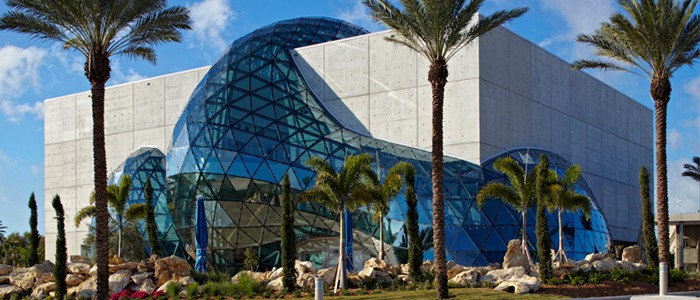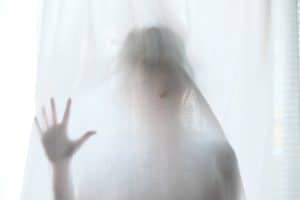 Imagine a Florida vacation: calm sandy beaches on the Gulf, fruity drinks, theme parks, exotic wildlife, and long evenings spent with friends might all come to mind. Many people don’t necessarily count museum visits among their top tropical vacation things-to-do, and far fewer would list lobster phones and melting clocks. On a recent trip to St. Petersburg Florida, though, I knew that one of the things I absolutely did not want to miss was the Salvador Dali Museum.
Imagine a Florida vacation: calm sandy beaches on the Gulf, fruity drinks, theme parks, exotic wildlife, and long evenings spent with friends might all come to mind. Many people don’t necessarily count museum visits among their top tropical vacation things-to-do, and far fewer would list lobster phones and melting clocks. On a recent trip to St. Petersburg Florida, though, I knew that one of the things I absolutely did not want to miss was the Salvador Dali Museum.
I first became fascinated with Dali’s art completely by chance when I was studying abroad in London. While walking along the River Thames I stumbled upon a travelling exhibit, The Dali Universe. What else can you do when you see larger-than-life spindle-legged elephants and melting clock sculptures set against a backdrop of classic London attractions? You just have to explore! In the Dali Universe gallery I discovered some of Dali’s most iconic, and also less well known, paintings, sculptures, furniture, and fashion, including Cabinet Anthropomorphique and Space Elephant. I was completely unprepared for what I encountered, but I was hooked. I knew that if I ever had another chance to see Dali’s work firsthand, I’d take it.
Cut to early summer 2017. The Salvador Dali Museum, known by locals as “The Dali,” stands on the waterfront in Old St. Petersburg. The museum’s collection is largely comprised of the extensive personal collection of Reynolds and Eleanor Morse. The Morses began collecting Dali’s work in the early 1940s, and even met and became good friends with Dali and his wife, Gala. Although The Dali’s collection includes works from all periods of Salvador Dali’s long and varied career, the collection is still weighted toward those bodies of work which the Morses most preferred: Dali’s early work which was heavily influenced by Impressionism and the pursuit of highly technical skill, certain surrealist subject matter, and his “nuclear mysticism,” which featured images of religious, historical, and scientific themes. Today, the museum houses the largest collection of Dali’s work outside of Europe.
The building itself embodies the spirit of Dali’s work by combining the rational with the fantastical. The original Dali Museum in St. Pete’s opened in 1982, and this new construction was completed in early 2011. The museum is a simple rectangle, out of which flows an eye-catching free-form geodesic bubble. This glass structure is known as the “enigma,” and though it looks fanciful, the enigma is actually made up of 1,062 pieces of triangular glass, each one cut to unique and specific dimensions; no two pieces are the same. The enigma isn’t the museum’s only mathematical marvel either. The middle of the airy building features a helical staircase reminiscent of the DNA spiral, something that appeared often in Dali’s work.
So, who was this international man of mystery, Salvador Dali? Dali was born in 1904 in Figueres, Spain. His talent was apparent at an early age, and he attended drawing school and studied art in university. He gained a high degree of technical skill, and as a young adult began to experiment with more modern and avant-garde forms of art, including Cubism and Dadaism. He is probably best known for his works as a Surrealist artist, however, with “The Persistence of Memory,” featuring the famous melting clocks, being his most well-known work. Later, Dali became fascinated with science, nature, and religion, incorporating elements of all three into his paintings. Several of the grandest of these works are housed at the Dali Museum and measure over 10 feet by 13 feet. Dali did not restrict himself to painting. He produced many works of art in sculpture, film, fashion, photography, and furniture.
Dali the man was every bit as grandiose and bizarre as his artwork. He was expelled from the inner circle of surrealist artists for his narcissism and pursuit of prominence, and was famously quoted as saying, “Each morning when I awake, I experience again a supreme pleasure – that of being Salvador Dali.” His pointy, long, flamboyant mustache is famous the world over, and his personal eccentricities sometimes overshadowed his artwork.
I’ve barely been able to scratch the surface of the Dali’s work and fascinating life. To learn more about the man and his art, check out these books from the Morrill Memorial Library: “The Secret Life of Salvador Dali” by Salvador Dali, “The Persistence of Memory: A biography of Dali” by Meredith Etherington-Smith, “The World of Salvador Dali” by Robert Descharnes, “Salvador Dali” by Jessica Hodge, and “This is Dali,” a partially graphic novel by Catherine Ingram and Andrew Rae. And if you’re ever in St. Pete’s, absolutely visit The Dali – you won’t be disappointed.
Liz Reed is an Adult and Information Services Librarian at the Morrill Memorial Library in Norwood, Massachusetts. Read Liz’s column in the July 6th edition of the Norwood Transcript and Bulletin.




